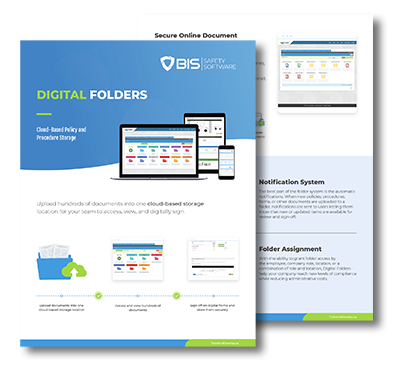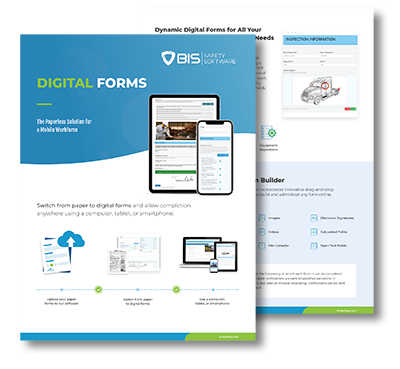Truck Pre-Trip Inspection Forms

A pre-trip inspection is vital for the safety of drivers and all road users, as it checks the truck’s various components to ensure they are operational and defect-free, thus preventing potential accidents. This blog post offers guidance on creating pre-trip inspection forms that adhere to the standards of CCMTA, NSC, and CCOHS.
We will also discuss advanced strategies for simplifying these forms and the potential consequences of neglecting to complete pre-trip inspections in Canada.
Explore this Article:
What is a Pre-Trip Inspection Form?
Components Typically Included in a Pre-Trip Inspection Form:
- Engine and Transmission: Checks for leaks, proper fluid levels, and belt integrity.
- Brakes and Air Systems: Ensures brakes are functioning correctly and air pressure is stable.
- Wheels and Tires: Inspects for proper inflation, tread wear, and damage.
- Lights and Electrical Systems: Verifies that headlights, brake lights, turn signals, and other electrical systems are operational.
- Steering and Suspension: Assesses the condition of steering components and suspension stability.
- Cargo and Safety Equipment: Examines cargo securement and the availability of required safety equipment like fire extinguishers and warning triangles.
- Cab and Body: Looks for damage or issues with the cab structure, mirrors, windshield, and wipers.

Creating a Pre-Trip Inspection Form That Adheres to CCMTA, NSC, and CCOHS Standards
To ensure compliance throughout Canada, it’s crucial to incorporate standards from CCMTA, NSC, and CCOHS. Consider the following checks:
- Engine Compartment: Check oil levels, hoses, belts, the air filter, and for any leaks.
- Cab Inspection: Look for damage to the windshield, mirrors, lights, and windshield wipers. Ensure the horn, emergency brakes, and seat belts are functioning properly.
- Front End: Inspect the steering system, brakes, tires, and wheels.
- Trailer Inspection: Verify the condition of the trailer’s brakes, tires, wheels, and lighting.
- Rear End: Check rear lights, brakes, tires, and wheels.
- Specialized Equipment: Include any specialized equipment like liftgates or refrigeration units.
- Documentation: Document any defects found and actions taken during the inspection.
Creating a Pre-Trip Inspection Form That Adheres to CCMTA, NSC, and CCOHS Standards
To ensure compliance throughout Canada, it’s crucial to incorporate standards from CCMTA, NSC, and CCOHS. Consider the following checks:
- Engine Compartment: Check oil levels, hoses, belts, the air filter, and for any leaks.
- Cab Inspection: Look for damage to the windshield, mirrors, lights, and windshield wipers. Ensure the horn, emergency brakes, and seat belts are functioning properly.
- Front End: Inspect the steering system, brakes, tires, and wheels.
- Trailer Inspection: Verify the condition of the trailer’s brakes, tires, wheels, and lighting.
- Rear End: Check rear lights, brakes, tires, and wheels.
- Specialized Equipment: Include any specialized equipment like liftgates or refrigeration units.
- Documentation: Document any defects found and actions taken during the inspection.
While the specifics may vary by truck type and industry, the above components are commonly included in Canadian truck pre-trip inspection forms.
For detailed guidance, refer to the National Safety Code (NSC) Standard 13 pre-trip inspection form. This form complies with the requirements of the Canadian Council of Motor Transport Administrators (CCMTA) and NSC Standard 13.
The NSC Standard 13 form contains sections for both driver and vehicle inspections:
- Driver Section: Includes items like seat belts, mirrors, and brakes for the driver to inspect.
- Vehicle Section: Features a checklist for the driver to examine the truck’s tires, lights, and engine.
Designed for clarity and ease of use, the NSC Standard 13 form includes straightforward instructions, visual aids for thorough inspections, and spaces for noting any defects or issues found. It also provides guidelines for reporting these issues to fleet managers.
Using a compliant form like the NSC Standard 13 is crucial for maintaining safety standards and ensuring that all trucks are roadworthy before operation.
Streamline Your Truck Pre-Trip Inspection Form for Ease of Use
Pre-trip inspections are critical for driver safety and roadway safety, yet they can be labor-intensive and time-consuming. Here are some strategies to simplify the pre-trip inspection process for truck drivers:
- Provide Clear, Concise Instructions: It’s important that drivers have straightforward and succinct guidelines on how to perform pre-trip inspections. These instructions should be easy to follow, outlining each step clearly and indicating how to record any discovered issues.
- Offer Training and Support: For drivers who are new to the process or unfamiliar with their truck’s specific components, providing training and support is crucial. This ensures that drivers are well-informed and comfortable with the inspection procedures, which can help decrease mistakes and enhance the accuracy of inspections.
- Enhance Visibility of the Inspection Checklist: Ensuring that the inspection checklist is easily accessible and visible within the truck’s cab is essential. This visibility helps remind drivers of the necessary checks and guarantees that no critical steps are overlooked.
- Foster Open Communication: It’s vital for drivers to feel at ease when reporting any problems they encounter during inspections. Fleet managers should promote open communication and facilitate easy reporting of any concerns or issues. This approach aids in quick resolution of potential problems and helps prevent minor issues from escalating.
- Implement Digital Forms: Adopting digital forms for pre-trip inspections can significantly streamline the process. These electronic forms can be customized to match the specific needs of your fleet and automatically guide drivers through each inspection point. Digital forms can also automatically update based on changes in compliance requirements, ensure that no items are overlooked by using mandatory fields, and simplify the documentation process by allowing drivers to enter information directly on a tablet or smartphone. This not only speeds up the inspection process but also improves data accuracy and makes it easier to track and analyze inspection data over time.

Employ Software to Manage Your Pre-Trip Inspection Forms
Consequences of Neglecting Pre-Trip Inspections
In Canada, penalties for skipping pre-trip inspections can vary by province and territory, typically ranging from $250 to $1,000 for a first violation, with potential increases for repeated offenses.
For instance, in Ontario, under the Highway Traffic Act, a commercial vehicle operator might face a $250 fine for neglecting to perform a pre-trip inspection or not conducting a mandated safety check. This fine escalates to $500 for a second violation within a year and $1,000 for any further offenses during the same period.
It’s crucial to remember that pre-trip inspections are not just a legal requirement but are also essential for the safety of the driver, the vehicle, and other road users. Regular and thorough inspections are imperative to avoid fines and ensure safety on the roads.
Related Articles
- All Posts
- #EmergencyPreparedness
- 2025 safety trends
- 360 Immersive
- 360immersive
- 6S Safety
- accident prevention
- accidental careers
- accountability
- adjustable workstations
- adult education
- AFAD
- AI automation
- AI implementation
- AI in business
- AI in operations
- AI in Safety
- AI podcast
- AI strategy
- AI transformation
- Airborne Hazards
- Alberta safety
- Alberta safety courses
- Allan James Moore
- Anhydrous Ammonia
- artificial intelligence
- asking for help
- audit findings
- audit readiness
- Audit Reporting
- automated compliance workflows
- automation in safety
- automation strategy
- avoidable injuries
- awareness
- Aztec Safety
- back strain
- BambooHR integration
- Bear safety
- behavior-based safety
- Behavioral Safety
- behavioural safety
- biometric sensors
- BIS Podcast
- BIS Safety Podcasts
- BIS Safety Software
- BIS Safety Spotlight
- black holes
- Blame Culture
- Blue Angels
- Boom Lift Safety
- BP Texas City Explosion
- Brave Leadership
- Brett Burkard
- bump test
- burnout
- business automation
- calibration
- call before you dig
- Canadian Compliance
- Canadian OHS
- Canadian safety
- Canadian safety history
- Canadian Safety Regulations
- Canadian safety standards
- Canadian wilderness safety
- CAPA tracking system
- carbon monoxide
- Cargo Securement
- Carolynne Heron
- CCOHS
- chemical
- Chemical Safety
- chemical vapors
- chronic injuries
- chronic pain
- cloud-based safety tools
- Coming Soon
- Commercial Drivers
- Commercial Vehicle Safety
- Communication in Safety
- Communication Systems
- community safety programs
- Competency in Safety
- complacency in safety
- Compliance
- compliance courses
- Compliance In Canada
- compliance issues
- Compliance management
- Compliance Reporting
- compliance software
- compliance software providers
- compliance tools
- compliance tracking
- compliance training
- compliance vs protection
- confined space
- Confined Space Safety
- connected safety systems
- Construction advocacy
- Construction education
- Construction industry
- construction safety
- construction safety training
- construction technology
- ConstructionSafety
- continuous improvement
- continuous safety improvement
- corporate culture
- corporate training
- corrective actions
- CPR and AED
- crane
- CSA standards
- Customer Spotlight
- Customer Spotlight Kevin Swinden Global Hazmat Safety Culture Hazmat Management Dangerous Goods Competency in Safety Workplace Risk Mitigation BIS Training Clients Canadian EHS
- customized training
- daily trip inspection
- Damage Prevention
- Dangerous Goods
- dangerous goods classification
- Danny Sellers
- data-driven safety
- debriefing
- Decision Analysis
- Decision quality
- defect management
- defect tracking
- defensive driving
- DEI in onboarding
- digital badges
- digital compliance
- digital FLHA
- digital forms
- Digital Hazard Reporting
- Digital Onboarding
- digital safety
- Digital Safety Audits
- digital safety meetings
- Digital Safety Solutions
- Digital safety systems
- digital safety tools
- digital safety transformation
- digital site access
- Digital Training Tools
- digital transformation
- DMS features
- document control
- document management system
- Dr. Joanna Pagonis
- Dr. Tom Krause
- Driver Fatigue
- driver file management
- driver training
- driving instructor program
- DTRMS
- Duty-Time Management
- e-learning
- e-learning tools
- eadership in safety
- early intervention
- education technology
- EHS
- EHS Adoption
- EHS analytics solutions
- EHS Compliance
- EHS demo questions
- EHS digital solutions
- EHS Inspections
- EHS leadership
- EHS Onboarding
- EHS software
- EHS software features for workplace safety
- EHS software vendor selection checklist
- EHS Strategy
- EHS system connectivity for safety excellence
- EHS systems
- EHS technology
- EHS tools
- EHS vendor review
- Einstein
- ELD
- electrical safety
- Elevated Work Safety
- elite performance
- Emergency Action Plan
- emergency preparedness
- emergency procedures
- emergency response
- emergency supplies
- emotional training
- EmpathyInLeadership
- employee behavior
- employee engagement
- employee health
- Employee onboarding
- employee preparedness
- Employee Readiness
- employee safety
- employee training
- employee trust
- Employee Well-Being
- EmployeeEngagement
- Employer Responsibilities
- Energy Isolation
- engaging toolbox meetings
- equipment inspections
- Equipment Operation
- Equipment Safety
- ergonomic consulting
- ergonomic design
- ergonomic risks
- ergonomics
- Evacuation Procedures
- evidence collection
- EWI Works
- excavator safety essentials
- exoskeleton
- exoskeletons
- failure analysis
- fall prevention
- fall protection
- fast onboarding
- field experience
- field level hazard assessments
- field operations
- field safety
- field safety assessments
- field safety communication
- field safety leadership
- field safety services
- Field Safety Technology
- field safety tools
- Field-Friendly Software
- Fire Drills
- fire prevention
- Fire Safety Training
- first aid
- first aid kit
- first week on the job
- first workplace injury
- Fit Testing
- flaggers
- Fleet Compliance
- fleet management
- fleet safety
- FLHA engagement
- FLHA Integration
- FLHA software
- floor mats
- FMEA
- freight
- Frontline Engagement
- frontline safety
- fuel handling
- future of work
- gas detection
- gas monitors
- Gas Respirator Safety
- Gas Safety
- Global Hazmat
- global onboarding
- Good Samaritan laws
- gravitational waves
- gut feeling in safety
- hand injuries
- handling hazardous materials
- hands-on training
- hazard analysis
- hazard assessment compliance
- hazard assessment software
- Hazard Awareness
- hazard communication
- Hazard Control
- Hazard Identification
- hazard prevention
- hazard recognition
- hazard reporting
- hazard reporting technology
- hazard tracking
- Hazardous Energy Control
- Hazardous Materials
- Hazmat Management
- Health & Safety Podcast
- health and safety
- hearing loss prevention
- hearing protection
- heavy equipment operation
- heavy equipment safety
- hidden workplace hazards
- high voltage systems
- High‑performance teams
- HOS Training
- Hours of Service
- HR automation
- HR software
- HR technology
- human factors
- human factors in safety
- human in the loop
- Human Performance
- human vs machine
- human-centered design
- human-centered safety
- Human-Centred Safety
- HumanCenteredLeadership
- Humble leadership
- humor in safety
- hydrogen sulfide
- ICBC certification
- ice melt
- identification
- immersive learning
- Imposter Syndrome
- incident data
- incident investigation
- incident management
- incident prevention
- incident prevention software
- incident reporting
- inclusive leadership
- industrial AI
- Industrial Hygiene
- industrial safety
- Industrial Training
- influence vs control
- Infrastructure Risk
- injury consequences
- injury prevention
- injury prevention tips
- injury recovery
- injury reporting
- injury response
- injury response plan
- inspections
- instant hazard logging
- instructor development
- internal audits
- international workforce
- interpreting safety data
- invisible dangers
- isk and compliance software
- ISO standards
- Jeff Mulligan
- Jennifer Lastra
- job site accountability
- job site hazards
- job site risks
- job site safety
- jobsite readiness
- Jody Young
- KBR Safety Training
- Kevin Swinden
- labor movement
- ladder safety
- Landscaping Ergonomics
- Landscaping Safety
- Leadership
- leadership accountability
- leadership and empathy
- Leadership by example
- Leadership Development
- Leadership in Safety
- Leadership Management
- leadership messaging
- Leadership trust
- LeadershipDevelopment
- Lean Manufacturing
- Lean Workplace
- learning from incidents
- learning management
- lifting techniques
- lighting
- LIGO
- Linda Miller
- LMS
- LMS features
- LMS software
- Load Securement
- Lock Out Tag Out
- lockout tagout
- Lone Worker Safety
- lone workers
- LOTO
- LOTO Training
- machine learning
- Machine Safety
- Maintenance Safety
- mental health at work
- Mentorship in Safety
- MEWP Training
- MI Safety
- microlearning
- Mike Schwartz
- minor injuries
- mobile FLHA solution
- mobile inspections platform
- mobile onboarding
- Mobile Safety Apps
- Mobile Safety Platforms
- mobile safety reporting
- Mobile Safety Tools
- mobile safety tools safety compliance solutions
- MOU Standards
- mould hazards
- mould prevention
- movement in workplace
- Multi-Contractor Worksites
- multilingual training
- MyZone AI
- Near Miss Reporting
- new hire experience
- New Hire Safety
- New Worker Training
- new workers
- no-blame investigations
- noise exposure
- nonconformance
- Northern BC
- NRCA
- NSC Standard 13
- occupational fatigue
- occupational hazards
- occupational health
- Occupational Health and Safety
- Occupational Health and Safety (OHS)
- occupational health risks
- occupational safety
- occupational therapy
- OH&S
- OHS
- OHS Career Advice
- OHS Compliance
- OHSA
- oil and gas safety
- omni-training
- On-Site Safety
- onboarding Canada
- onboarding safety
- Onboarding Software
- online learning
- online orientation software
- Online safety training
- operational efficiency
- Operational Excellence
- Operational risk
- organizational culture
- organizational safety
- OSHA compliance
- OSHA standards
- outdated practices
- Outdoor work hazards
- overconfidence
- overhead crane courses
- pain awareness
- paperless safety reporting
- paperless safety talks
- PDCA Cycle
- personal protective equipment
- Pharmaceutical Safety
- physics careers
- pipeline safety
- playbook software
- podcast
- post-accident review
- post-incident protocol
- PPE
- PPE enforcement
- PPE improvement
- PPE Training
- pre-trip inspection
- predictive analytics
- pretrip inspection
- Preventative Safety
- preventing shortcuts
- preventive action
- proactive risk management
- proactive safety
- proactive safety culture
- proactive safety measures.
- Proactive Safety Systems
- process improvement
- Professional development
- propane safety
- propane storage
- protective clothing
- psychological hazards
- psychological safety
- PsychologicalSafety
- quality control
- quality management
- quality standard
- Real Safety Leadership
- real-time hazard reporting
- Real-Time Reporting
- real-time safety
- real-time safety tools
- real-time site data
- recordkeeping
- reduce training costs
- regulatory updates
- repetition in safety
- repetitive motion injuries
- respirator safety
- respirators
- Respiratory Protection
- risk assessment
- risk management
- risk mitigation
- risk prevention
- Risk Prevention Tools
- risk reduction
- road safety
- Robin Postnikoff
- ROI with AI
- root cause analysis
- root cause correction
- routine task risks
- safe excavation
- safe habits
- safe transport
- safe work habits
- safe work practices
- safety
- safety accountability
- safety advice
- safety analytics integration
- safety article
- Safety Audit Software
- safety automation
- safety automation tools
- safety awareness
- Safety Behaviour
- safety behaviour science
- safety best practices
- safety communication
- safety compliance
- Safety Conversations
- safety culture
- safety culture transformation
- safety data
- safety data sheets
- safety documentation
- safety engagement
- safety follow-up
- safety gear
- safety gloves
- safety goggles
- safety habits
- safety improvement
- safety incentives
- safety innovation
- safety insights
- safety inspection
- safety instinct
- Safety Leaders
- safety leadership
- Safety Leadership Podcast
- safety legislation
- safety lessons
- safety management
- safety management system
- safety management systems
- safety metrics
- safety mindset
- safety motivation.
- safety myths
- safety onboarding
- safety planning
- safety podcast
- safety procedure updates
- Safety Procedures
- safety process improvement
- Safety Professional Development
- safety professionals
- Safety Programs
- safety reporting
- safety review process
- safety shortcuts
- safety software
- safety software evaluation
- Safety Spotlight
- Safety strategy
- safety systems
- safety technology
- safety technology buyers guide
- safety theater
- safety tips
- safety tools
- safety training
- safety transformation
- safety transparency
- SafetyCulture
- SafetyLeadership
- Sarah Anderson
- scaffold safety
- scaffolding inspections
- scalable training solutions
- Scott Lyall
- SDS
- shipping documentation
- silent dangers
- silica dust
- Sinogap Solutions
- slips trips falls
- slow-building hazards
- smart helmets
- smart PPE
- smart safety systems
- smart safety tools
- Social Learning
- SOPs
- space science
- speak-up culture
- Spencer McDonald
- Standardized Work
- stop work authority
- storytelling and safety
- storytelling in safety
- supervisor training
- system safety
- Systems Thinking in Safety
- tablet-based toolbox talks
- TCP safety
- TDG
- team communication
- team performance
- teamwork
- tech and ergonomics
- tech in safety
- tech-enabled learning
- Thinking Driver
- Titan Environmental
- Tom Krause
- toolbox talks tablets
- Total Recordable Injury Formula
- tough guy mentality
- toxic air
- Toyota Motor Manufacturing Canada
- traction control
- traffic control
- traffic control plan
- training
- training courses
- Training integration
- training management
- training matrix
- training record management
- training records
- training software
- TrainingAndDevelopment
- transportation
- transportation of dangerous goods
- Transportation Regulations
- Transportation Safety
- Trucking Regulations
- trust
- Trust & Accountability
- Trust & Communication
- Trust and Accountability
- trust at work
- Underground infrastructure
- underground utilities
- unseen workplace threats
- Upward communication
- user experience
- utility line marking
- utility locating
- Utility safety
- Utility Safety Partners
- values-based onboarding
- vehicle safety
- version control
- veteran advice
- Virtual Reality
- VR safety training
- VR Technology
- walkway maintenance
- wearable technology
- Weights and Dimensions
- Wellness at Work
- WHMIS
- Wildlife awareness
- winter safety
- witness statements
- women in leadership
- work zone safety
- work-alone training
- work-related injuries
- worker accountability
- worker advocacy
- worker fatigue
- worker protection
- worker safety
- worker safety habits
- worker safety tips
- Worker Safety Training
- worker trust
- worker wellbeing
- workers' rights
- Workforce Automation
- workforce compliance
- Workforce development
- workforce engagement
- workforce management
- Workforce Readiness
- workforce training
- Working Alone Canada
- workplace accidents
- workplace air quality
- workplace best practices
- workplace certification
- workplace compliance
- Workplace Culture
- workplace hazard prevention
- Workplace Hazard Tracking
- workplace hazards
- workplace health
- workplace incident response
- workplace injuries
- workplace injury prevention
- workplace inspections
- workplace leadership
- workplace mindset
- Workplace Organization
- workplace readiness
- workplace risk factors
- workplace risk management
- Workplace Risk Mitigation
- Workplace safety
- Workplace Safety Compliance
- workplace safety culture
- Workplace Safety Leadership
- workplace safety rules
- workplace safety tech
- workplace safety tips
- Workplace Safety Tools
- workplace safety training
- workplace stress
- workplace tiredness
- workplace trust
- workplace wellness
- WorkplaceSafety
- WSPS

Erin leads with empathy, communication, and genuine connection, focusing on what workers experience every day. By building trust, encouraging open...

Melanie McGrath shifts workplace safety from policy and checklists to a people-led safety leadership culture rooted in trust, ethical leadership,...

Ethan Winder’s approach to safety leadership goes beyond rules, he focuses on communication, trust, and understanding the real work people...




























